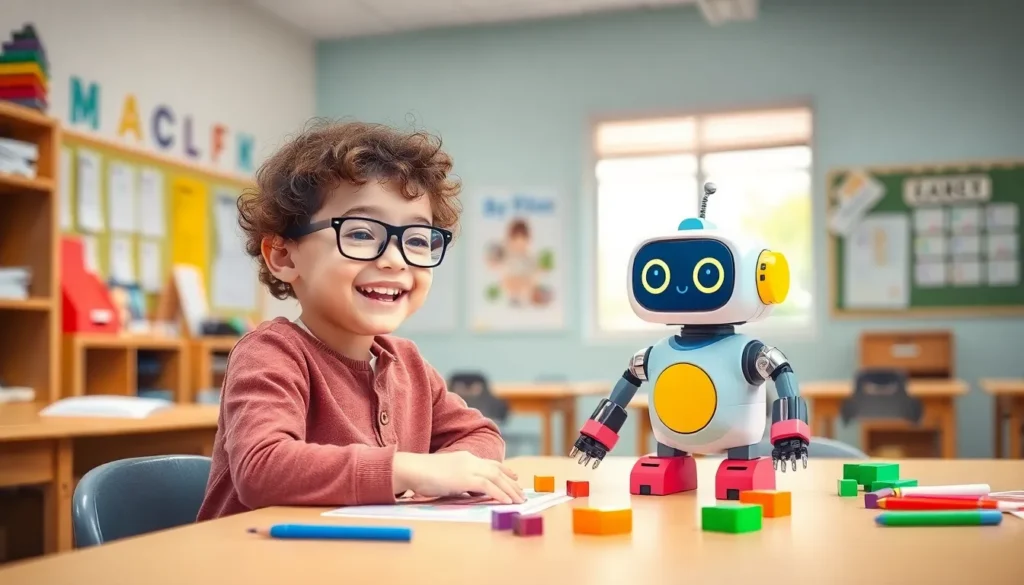Table of Contents
ToggleArtificial intelligence isn’t just for tech geeks in lab coats anymore. It’s sneaking into classrooms and playrooms, ready to make learning fun and engaging for kids. Imagine a world where children can chat with their own friendly robot or create art with a few taps on a screen. Sounds like science fiction? Well, it’s happening right now!
As kids dive into the realm of AI, they’re not just playing—they’re building skills that’ll shape their futures. From coding their first game to understanding how voice assistants work, the possibilities are endless and exciting. So buckle up as we explore how artificial intelligence can spark creativity and curiosity in young minds, turning them into the innovators of tomorrow.
What Is Artificial Intelligence?
Artificial intelligence (AI) refers to computer systems designed to mimic human intelligence. These systems learn, reason, and solve problems similar to how people think.
Defining Artificial Intelligence
Defining AI involves understanding its core functions. AI encompasses machine learning, where computers analyze data and improve performance over time. Natural language processing allows machines to understand and generate human language. Robotics applies AI technologies to create machines that can perform tasks autonomously. Children engaging with AI tools may find coding and problem-solving enjoyable as they explore these concepts firsthand.
Examples in Everyday Life
Examples of AI are evident in daily experiences. Virtual assistants, like Siri or Alexa, help users manage tasks through voice commands. Recommendation systems on platforms like Netflix and Spotify suggest content based on user preferences. Many educational apps utilize AI to personalize learning experiences. In gaming, AI creates dynamic opponents that adjust difficulty levels according to player skills. These interactions demonstrate how AI permeates various aspects of life, making it a valuable tool for learning and creativity.
Why Teach Kids About Artificial Intelligence?

Teaching kids about artificial intelligence (AI) plays a crucial role in their development. Engaging with AI technologies prepares them for a future where digital skills are essential.
Benefits of Early Exposure
Early exposure to AI provides children with foundational knowledge. Understanding AI concepts creates pathways to careers in tech and innovation. Children grasp essential skills quickly when introduced to machine learning and programming. Familiarity with AI tools helps them adapt to evolving technologies. Skills gained now enhance problem-solving abilities. Learning through fun platforms builds confidence and curiosity.
Fostering Creativity and Critical Thinking
Creativity flourishes when kids interact with AI. They can explore unique art forms, music compositions, and storytelling methods. AI encourages experimentation and innovation in projects, broadening their artistic vision. Students learn to ask questions and analyze outcomes, enhancing critical thinking. Failure becomes part of the learning journey, leading to better solutions. Engaging with AI tools fosters a mindset of exploration. Such experiences cultivate future leaders and thinkers.
Understanding the Basics of Artificial Intelligence for Kids
Artificial intelligence introduces exciting learning opportunities for kids. Engaging with AI tools sparks creativity and curiosity among young learners.
How Machines Learn
Machines learn through a process called machine learning. They analyze vast amounts of data, just like how kids learn from experiences. By identifying patterns, algorithms make predictions or decisions without being explicitly programmed. For instance, when kids interact with educational apps, the apps adapt to their learning styles and progress. This personalized experience enhances skill development, making learning enjoyable. Real-world applications include voice recognition and image classification, showing how effective machine learning can be.
Types of Artificial Intelligence
AI can be categorized into two main types: narrow AI and general AI. Narrow AI focuses on specific tasks, such as recommending movies on Netflix or answering questions with Siri. These systems excel in limited areas, providing tailored responses based on user input. General AI, a more advanced concept, involves machines that possess human-like intelligence and can perform a wide range of tasks. Although general AI is still in development, understanding these types helps kids comprehend how AI influences their lives and future technologies.
Fun Ways to Introduce AI to Kids
Introducing AI to kids can take many exciting forms. Engaging them through interactive games and hands-on projects makes learning about technology enjoyable and educational.
Interactive Games and Apps
Interactive games and apps capture children’s attention while teaching them AI concepts. Platforms like Code.org and Scratch allow kids to develop coding skills through fun challenges. Additionally, AI-focused games, such as Google’s Teachable Machine, let kids train their models using their own data. Engaging visuals and playful interfaces keep learning dynamic. Each task encourages problem-solving and critical thinking. Children can play AI trivia games to learn about technology’s impact in an entertaining manner. These activities provide a direct connection between play and education, significantly enhancing understanding.
Hands-on Projects and Activities
Hands-on projects cultivate creativity and deepen understanding of AI. Building simple robots using kits like Lego Mindstorms introduces more advanced concepts. Crafting art with tools like DeepArt enables kids to merge creativity with technology. Creating interactive stories with AI chatbots allows children to explore storytelling methods. Each project presents unique challenges that promote critical thinking. Encouragement to experiment fosters a mindset of exploration and innovation. Engaging in these activities prepares them for future technology-driven careers while ensuring they enjoy the learning process.
Safety and Ethics in Artificial Intelligence
Artificial intelligence brings exciting opportunities for kids, so it’s vital to understand safety and ethical considerations.
Teaching Responsible Use
Teaching children to use AI responsibly is crucial. Engaging them in discussions about online behavior fosters awareness of digital footprints. Emphasizing the consequences of sharing personal information builds a foundation for safe interactions. Providing examples of responsible AI usage helps children grasp its significance. Encouraging questions allows kids to express their thoughts and concerns about technology. Integrating lessons on empathy and respect into AI discussions encourages thoughtful engagement with digital tools. Establishing clear guidelines for AI usage can enhance accountability. Reinforcing these principles helps children develop strong moral values as they navigate their digital landscape.
Addressing Privacy Concerns
Addressing privacy concerns around AI is essential for children. Children often don’t understand the information collected by AI applications. Educating them about data privacy helps them recognize the importance of protecting their personal information. Discussing real-world examples illustrates potential risks associated with data sharing. Parents and educators should explain how AI systems use data and ensure transparency in these processes. Encouraging kids to ask for permission before sharing information can instill good habits. Providing resources on privacy tools reinforces the importance of safeguarding personal data. Such discussions empower children to navigate the digital world more safely and responsibly.
Embracing artificial intelligence in children’s education opens doors to endless possibilities. As kids interact with AI tools they not only learn essential skills but also spark their creativity. Engaging with technology through coding and problem-solving prepares them for a future driven by innovation.
Moreover teaching kids about responsible AI use fosters a sense of ethics and digital awareness. This balance between creativity and responsibility ensures they grow into informed individuals who can navigate the complexities of the digital age. By nurturing their curiosity and critical thinking abilities today they’ll become the innovators and leaders of tomorrow.





